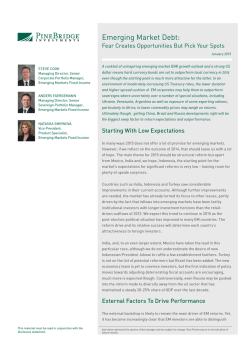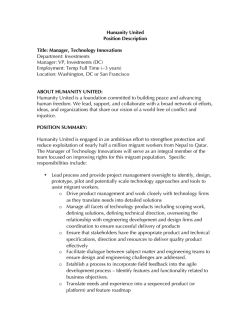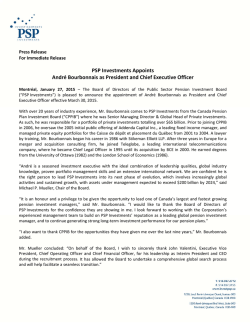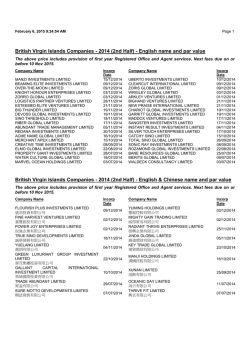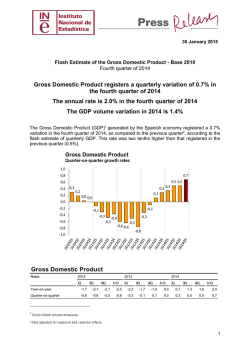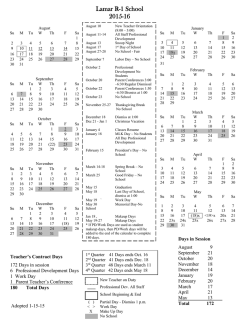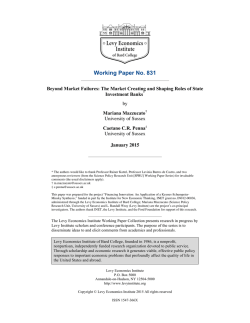
Asia Market Watch - PineBridge Investments
M o n t h l y m a r k e t C O M M ENTARY Asia Market Watch January 2015 Written by: Markus Schomer, CFA Managing Director, Chief Economist PineBridge Investments, New York Two major trends are reshaping the global economic outlook. One is the sharp drop in oil prices. Since last summer the price of a barrel of Brent crude has fallen more than 55% compared to its fairly steady average of the previous 18 months. The result is a serious redistribution of purchasing power away from oil producers who are typically net savers to oil consumers who are more likely to spend the additional income. Asia looks like the biggest winner. In 2013 the region consumed almost four times as much oil as it produced. Hence, the positive impact on consumption should greatly outweigh any negative impact on mining investment. The second effect is the dramatic swing in global currency markets. The euro’s weakness increased significantly in January after the European Central Bank’s decision to start a large scale asset-purchase program. The Bank of Japan is already mulling yet another increase in Quantitative Easing (QE), which is keeping the yen weak. However, attempts to stimulate growth through weaker currencies always produces losers on the other side. Many of those are in the rest of Asia. China’s US dollar peg is now tying its slowing economy to the improving trajectory the US is on. The renminbi is up 17% in the past six months. Other currencies have experience similar appreciation. Hong Kong’s dollar is up 18%, Taiwan up 13% and South Korea up 12%. Against the broader trend, Asian currencies actually had a fairly good January. Japan’s yen and the Indian rupee gained about 1.5% and 2.5%, respectively. South Korea and Taiwan also posted stronger currencies. Asian equity markets also had a good start to the year. Most of the developed Asian markets were up between 1% and 2%, except Hong Kong were stocks surged about 5% in January. Markets in India and China were up even more, adding to the bullish trend. Asian sovereign bonds also delivered positive returns in January, though the region underperformed the JP Morgan Global Diversified EM Bond Index. We continue to look for evidence of a rebound in Japan after last April’s Consumption Tax increase pushed the economy into the fourth recession since 2008. I guess that would be a ‘QuadrupleDip’. Japan’s All Industry Activity Index, a monthly GDP proxy, started to grow again in September, but showed no improvement in momentum during October and November. Purchasing Managers Indices are back above 50 – yet only barely so – adding to the perception that the recession may be ending, but the recovery lacks impetus . One area where we see a more significant improvement is trade. Exports have increased notably in the past few months, growing at an annualized rate of 18% in the third and 25% in the fourth quarter. However inefficient QE is as a policy tool to boost domestic economic activity – or inflation for that matter – it did reverse the post-2008 yen strength that had driven Japan’s trade-weighted effective exchange rate to a new all-time high. Hence, we expect growth to rebound in Japan, reaching 1.7% in 2015 after a disappointing 0.2% last year. Latest data showed China’s economy grew 7.3% from a year ago in the fourth quarter, the same rate as in the previous period. Yet, headlines focused on the growth rate for the entire year, which at 7.4% was the weakest in 24 years, though only by a few tenths. Looking ahead, China is one of the main beneficiaries of the steep decline in oil prices. It posts the biggest consumption/production surplus of all the major Asian economies. China’s two manufacturing PMI indices deteriorated in December, slipping just below the critical 50 threshold. While it seems broader manufacturing activity remains stagnant, the trend in retail sales and industrial production improved towards the end of the year suggesting the recent growth momentum may carry over into the current year. In early January, the IMF downgraded growth expectations for China by -0.3% to 6.8% this year and by -0.5% to 6.3% in 2016. The fund acknowledged the positive effect of lower oil prices, which on its own should lift Chinese GDP growth this year between 0.4% and 0.7%. However, the fund believes that impact is overwhelmed by weaker investment spending. So without the drop in oil prices, would growth forecast have fallen by a full percentage point to 6.3% this year? We believe that assessment is too bearish and does not take into account further monetary policy support and stronger export demand. In our latest projections, we expect China to grow 7.1% this year and 7% in 2016. Weaker growth trends dominate other developed Asian economies. Taiwan’s manufacturing PMI index fell to the expansion/contraction threshold of 50 in December. Industrial production stagnated in the fourth quarter, highlighting the loss of momentum after stronger growth over the summer. Manufacturing is in a similar slump in Hong Kong. After a tentative rebound in the first half of 2014, production declined again in the third quarter and a PMI index averaging 49 in the fourth quarter suggests growth remained weak at year-end. Singapore reported fourth quarter GDP growth easing to an annual rate of 1.5%, the slowest pace in more than two years. Consistent with weaker growth trends among its peers, the main driver was a contraction in manufacturing and a sharp slowdown in construction. Part of the sluggish growth momentum in the heavily export-oriented developed Asian economies is the weakness in global trade. The World Trade Organization (WTO) pinebridge.com expects merchandise trade to grow 4% this year. That is up from an even weaker 3.1% last year, but well below the 5% long term average. Another likely reason is currency appreciation versus the yen and euro. While Japanese shipments overseas accelerated strongly in the fourth quarter, Taiwan, Singapore and Hong Kong saw a contraction in exports during the same period. If this trend continues, pressure on local central banks could increase to match the policy easing in Japan and the Eurozone if circumstances allow. It is not just China that benefits from lower oil prices. India, Asia’s second largest economy, is another major net oil consumer. In China, a boost to consumer spending could help slow the pace of the growth slowdown. In India, lower oil prices are boosting an already improving recovery. India’s manufacturing PMI index improved to 54.5 in December, significantly above the global and regional averages. Not only will lower oil prices boost consumer spending, they will also slow inflation. That trend is already evident in India, where consumer price inflation slowed from 8% last July to just 5% in December. That drop is well ahead of the central bank’s target of 6% by the end of the year. Not surprisingly, the bank took advantage of the favorable inflation trajectory. Against expectation, the Reserve Bank cut rates in January, reversing the first of the three rate hikes forced on it in 2013 during the Fragile Five crisis. The IMF also downgraded its India growth forecasts for this year, though just by -0.1%. Nevertheless, I wonder how the fund justifies its more bearish outlook as lower oil prices, easier monetary policy and stronger real income growth are all new factors that were not part of the IMF’s World Economic Outlook last October. We expect India to grow 5.8% this year and 6.2% in 2016. Looking ahead, there are multiple macro trend we are keeping an eye on. Japan’s economy should post positive growth in the fourth quarter, ending its fourth recession since 2008. We have not seen any improvements in China’s preliminary PMI surveys. Yet lower oil prices should boost retail sales at the start of the first quarter, a tentative sign that the economy may be able to maintain a stronger-thanexpected growth momentum. Finally, further weakness in industrial activity and exports could trigger a new round of monetary policy easing, especially in South Korea and Taiwan. That would heat up the currency competition with Japan and the Eurozone. Written on 29 January 2015 For further information please contact your relationship manager or [email protected] PineBridge Investments is a group of international companies that provides investment advice and markets asset management products and services to clients around the world. PineBridge Investments is a registered trademark proprietary to PineBridge Investments IP Holding Company Limited. For purposes of complying with the Global Investment Performance Standards (GIPS®), the firm is defined as PineBridge Investments Global. Under the firm definition for the purposes of GIPS, PineBridge Investments Global excludes some alternative asset groups and regional legal entities that may be represented in this presentation, such as the assets of PineBridge Investments. Readership: This document is intended solely for the addressee(s) and may not be redistributed without the prior permission of PineBridge Investments. Its content may be confidential. PineBridge Investments and its subsidiaries are not responsible for any unlawful distribution of this document to any third parties, in whole or in part. Opinions: Any opinions expressed in this document may be subject to change without notice. We are not soliciting or recommending any action based on this material. Risk Warning: All investments involve risk, including possible loss of principal. Past performance is not indicative of future results. If applicable, the offering document should be read for further details including the risk factors. Our investment management services relate to a variety of investments, each of which can fluctuate in value. The investment risks vary between different types of instruments. For example, for investments involving exposure to a currency other than that in which the portfolio is denominated, changes in the rate of exchange may cause the value of investments, and consequently the value of the portfolio, to go up or down. In the case of a higher volatility portfolio, the loss on realization or cancellation may be very high (including total loss of investment), as the value of such an investment may fall suddenly and substantially. In making an investment decision, prospective investors must rely on their own examination of the merits and risks involved. Information is unaudited, unless otherwise indicated, and any information from third party sources is believed to be reliable, but PineBridge Investments cannot guarantee its accuracy or completeness.PineBridge Investments Europe Limited is authorised and regulated by the Financial Conduct Authority (“FCA”). In the UK this communication is a financial promotion solely intended for professional clients as defined in the FCA Handbook and has been approved by PineBridge Investments Europe Limited. Should you like to request a different classification, please contact your PineBridge representative.Approved by PineBridge Investments Ireland Limited. This entity is authorised and regulated by the Central Bank of Ireland. In Australia, this document is intended for a limited number of wholesale clients as such term is defined in chapter 7 of the Corporations Act 2001 (CTH). The entity receiving this document represents that if it is in Australia, it is a wholesale client and it will not distribute this document to any other person whether in or outside of Australia. In Hong Kong, the issuer of this document is PineBridge Investments Asia Limited, licensed and regulated by the Securities and Futures Commission (“SFC”). This document has not been reviewed by the SFC. PineBridge Investments Asia Limited holds a Representative Office license issued by the Central Bank of the UAE and conducts its activities in the UAE under the trade name PineBridge Investments Asia Limited– Abu Dhabi. This document has not been reviewed by the Central Bank of the UAE nor the SFC. In the UAE, this document is issued by PineBridge Investments Asia Limited – Abu Dhabi Representative Office. PineBridge Investments Singapore Limited is licensed and regulated by the Monetary Authority of Singapore (the ”MAS”). In Singapore, this material may not be suitable to a retail investor and is not reviewed or endorsed by the MAS. PineBridge Investments Middle East B.S.C.(c) is regulated by the Central Bank of Bahrain as a Category 1 investment firm. This document and the financial products and services to which it relates will only be made available to accredited investors of PineBridge Investments Middle East B.S.C. (c ) and no other person should act upon it. The Central Bank of Bahrain takes no responsibility for the accuracy of the statements and information contained in this document or the performance of the financial products and services, nor shall it have any liability to any person, an investor or otherwise, for any loss or damage resulting from reliance on any statement or information contained therein. 16 June 2014
© Copyright 2025
